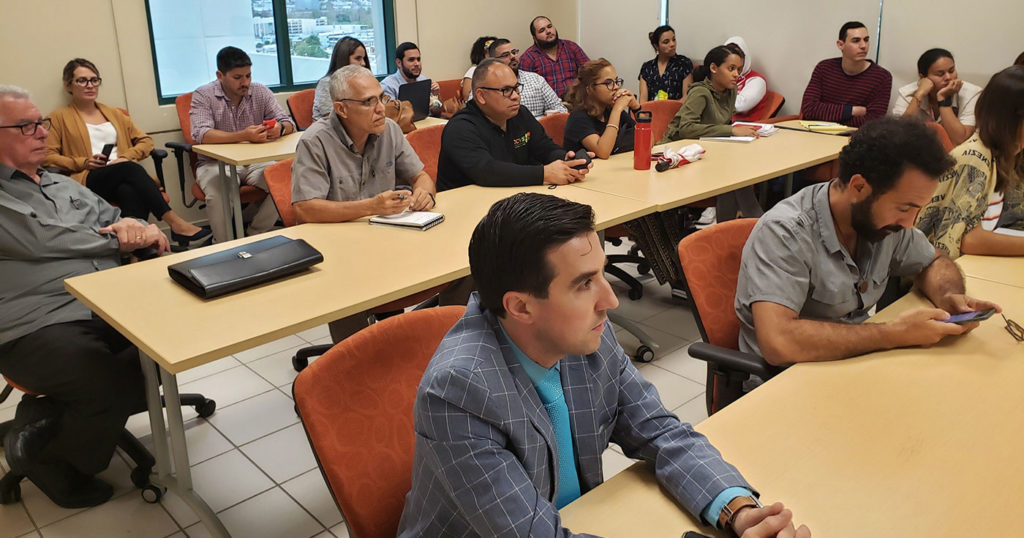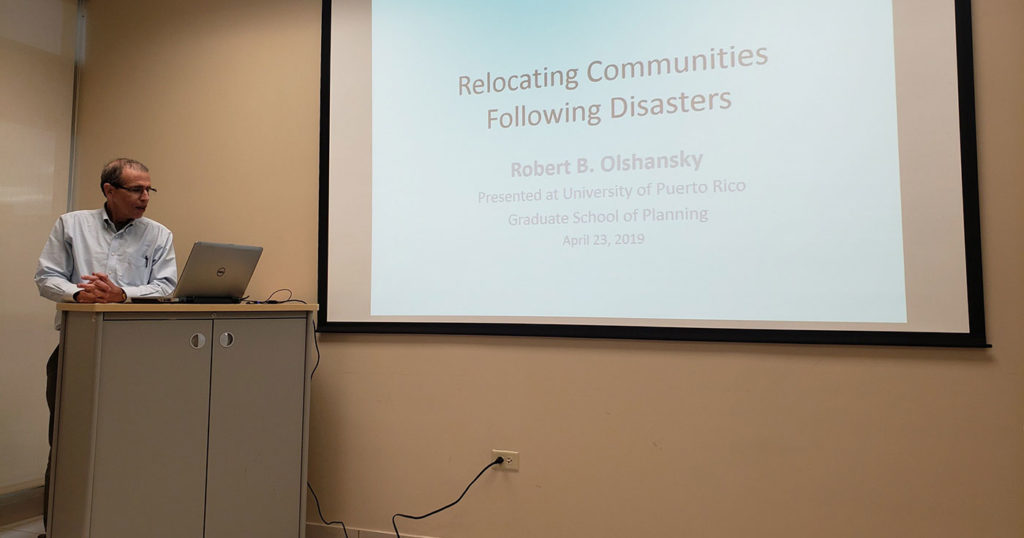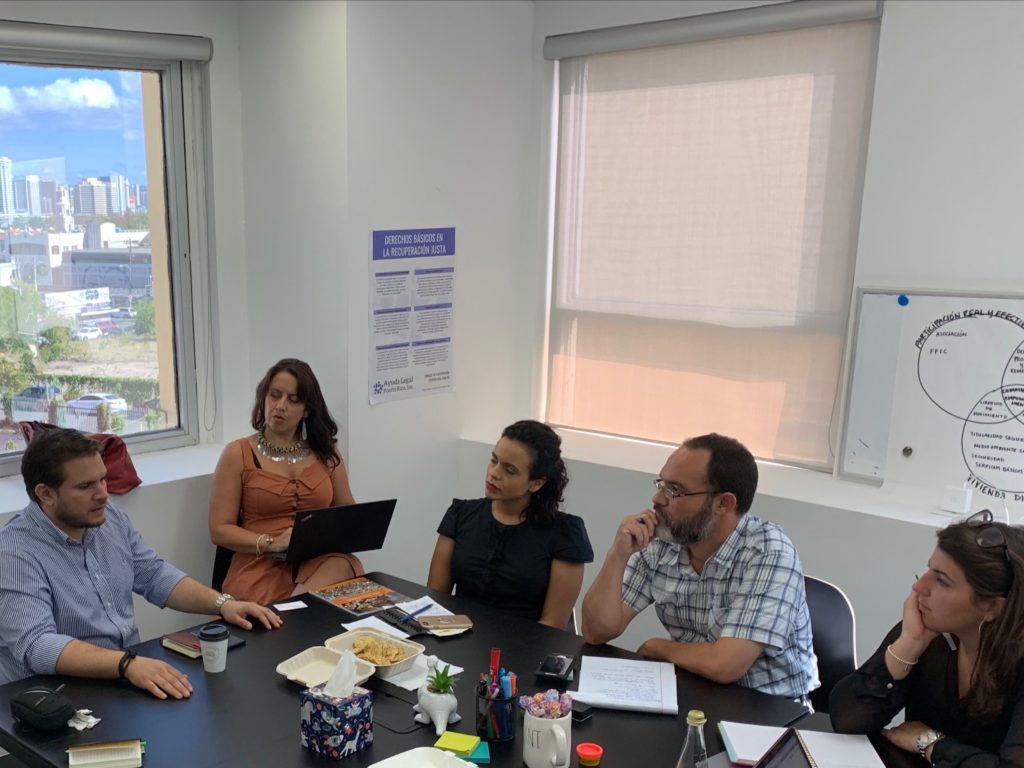Blueprint Initiative works with Global Expert on Post Disaster Planning and Reconstruction
Published on June 19, 2019
Center for a New Economy
SHARE
Blueprint, the CNE Growth Commission housing and land initiative, continues to provide a platform for the exchange of knowledge and information through a series of public gatherings and events. There is a need to broaden the discussion about housing in Puerto Rico in the post-disaster period, including issues pertaining to safe and durable housing; Blueprint achieves this by bringing together various sectors in collaborative efforts.
As part of this ongoing work, CNE welcomed Professor Robert B. Olshansky to Puerto Rico. Olshansky is emeritus professor of urban planning at the University of Illinois at Urbana-Champaign and an expert on post-disaster planning. During his visit, CNE researchers took him on comprehensive site visits to observe Puerto Rico’s post storms situation firsthand and collect relevant field data. Highlights of the visit include:


Lecture at the University of Puerto Rico Graduate School of Planning:
Prof. Olshansky gave a presentation on the relocation of at-risk communities following disasters, to a room full of planning students and professionals.


Successful Planning by Local Communities:
Prof. Olshansky conducted fieldwork and attended community meetings throughout the island. He visited El Caño Martín Peña in San Juan, Barrio Vietnam in Guaynabo, numerous communities in Toa Baja, Barrio Mameyes in Ponce and Barrio Guardarraya in Patillas. The visits helped confirm how some communities in Puerto Rico, through community-based and participatory planning efforts, are developing strategies for reducing vulnerability.
Post-Disaster Planning in Puerto Rico and Federal Support:
The rest of the visit focused on understanding the environment for making urban planning decisions and the reconstruction strategies pursued by key agencies. Meetings with officials from FEMA, HUD and the Puerto Rico Department of Housing helped Prof. Olshansky grasp the magnitude of the situation. These agencies will determine how spend federal funds such as: Community Development Block Grant – Disaster Recovery (CDBG-DR) funding, FEMA’s Hazard Mitigation Grants and FEMA’s Public Assistance funds.
Following his initial rounds of fieldwork in Puerto Rico, Prof. Olshansky observed the following:

“I understand that the process is guided by the Fiscal Plan, the Economic and Disaster Recovery Plan by COR3 and the Governor, and the HUD Action Plan, but post-disaster recovery is a complex and fluid process, demanding constant decision making, improvisation, monitoring, evaluation, and revision of priorities and strategies.
The process needs some sort of transparent and credible governance structure, preferably involving sets of representative committees and advisory bodies, making decisions in public view. I was disappointed that I could find nothing like this at all and that no one was able to tell me that such bodies existed.
Because of the limitations of all the official bodies, I also see opportunities for non-governmental organizations and groups of citizens to influence the course of the recovery process. They can articulate policies, propose solutions, and otherwise advocate for a larger public voice in recovery decisions. And I encourage the planning community to organize, help communities, and collectively advocate for a more transparent, community-based recovery process.
I also see an important role for CNE to monitor recovery activities, document problems, offer policy solutions, and otherwise provide an information base to help all of the many recovery actors, governmental and otherwise.”
The visit marked the starting point of a working relationship with Professor Olshansky, who has accepted our invitation to become a member of CNE’s Growth Commission.
“Rob Olshansky is a global expert on post-disaster planning and reconstruction issues. His latest book, After Great Disasters: How Six Countries Managed Community Recovery, coauthored with Laurie Johnson, is required reading for those of us who aim to achieve a just recovery in the island. His knowledge, insights and commitment to producing solid research will surely nurture the work of CNE’s Growth Commission, as we advance on the long journey towards rebuilding Puerto Rico,” expressed Deepak Lamba-Nieves, Research Director & Churchill G. Carey, Jr. Chair in Economic Development Research at CNE.
Through the Blueprint initiative, the CNE Growth Commission is addressing key areas that can help transform Puerto Rico’s recovery into locally-led growth. The commission’s mission to articulate policy strategies that foster long-term growth is now more relevant than ever.
The landscape of possibilities to achieve sustainable economic development for Puerto Rico has shifted considerably since the Growth Commission was established in 2016. Given the magnitude of the island’s socioeconomic crisis, devising economic development opportunities for Puerto Rico should be the top priority of local and U.S. and stakeholders. In the coming weeks, the Growth Commission will present a revamped strategy and program of action focused on the ensuing reconstruction.
The CNE Growth Commission is composed of world-class academics, policymakers, private sector representatives and civic leaders who possess expertise in diverse areas related to economic growth and development. Its members represent a variety of perspectives and thought currents.
CNE continues to work for Puerto Rico in this critical moment.
We thank you for your support!
